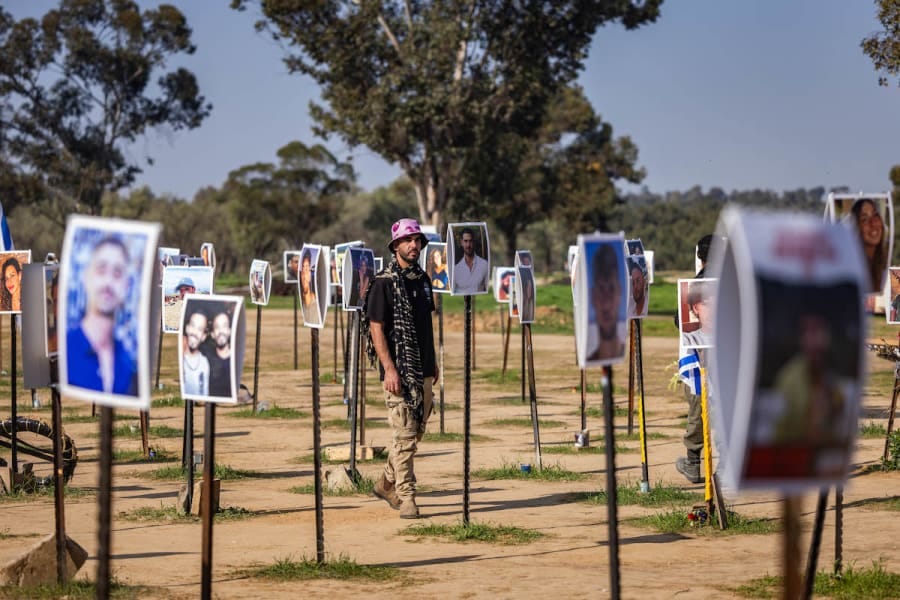The Painful Irony of Shemini Atzeret
A festive, and somewhat confusing day, will now be forever marred
Psalm 137:1-6
עַ֥ל נַהֲר֨וֹת ׀ בָּבֶ֗ל שָׁ֣ם יָ֭שַׁבְנוּ גַּם־בָּכִ֑ינוּ בְּ֝זָכְרֵ֗נוּ אֶת־צִיּֽוֹן׃
By the rivers of Babylon, there we sat, sat and wept, as we thought of Zion.
There on the poplars we hung up our lyres, for our captors asked us there for songs, our tormentors, for amusement: “Sing us one of the songs of Zion.”אֵ֗יךְ נָשִׁ֥יר אֶת־שִׁיר־ה' עַ֝֗ל אַדְמַ֥ת נֵכָֽר׃
How can we sing a song of the LORD on alien soil?אִֽם־אֶשְׁכָּחֵ֥ךְ יְֽרוּשָׁלִָ֗ם תִּשְׁכַּ֥ח יְמִינִֽי׃
If I forget you, O Jerusalem, let my right hand wither; let my tongue stick to my palate if I cease to think of you, if I do not keep Jerusalem in memory even at my happiest hour.
Last year on Shemini Atzeret, which fell on October 7th, 2023, I came to the realization that this festive day will, for the rest of my life, feel quite different.
Before then, it was already the most ironic holiday of the Jewish year, mostly because it is not clear whether it is the eighth day of Sukkot, or a holiday unto itself.
On the one hand, the word “shemini,” literally, “eighth,” refers to the fact that it follows the seventh day of Sukkot, clearly suggesting that this day is the eighth day of the festival*. In the Torah it is referred to as an “‘atzeret,” from the shoresh ע-צ-ר, that is, a day of stopping, the final day of a long festival. In our liturgy, whenever we mention Shemini Atzeret, we refer to it as “zeman simḥateinu,” the season of our joy, which is the same term we use for Sukkot. Whenever we mention the Shalosh Regalim, the three pilgrimage festivals, we count exactly three: Pesaḥ, Shavu’ot, and Sukkot. Absolutely nobody in the world ever counts Shemini Atzeret as the fourth festival.
But on the other hand, the Talmud (Sukkah 48a) describes this day as a “regel bifnei ‘atzmo,” a pilgrimage festival unto itself. And you may know that we are done with our Sukkot obligations - leshev basukkah, to dwell in the sukkah, and Arba’at HaMinim, the four species which comprise the lulav and etrog - after 7 days. If Shemini Atzeret were actually a part of Sukkot, then we would still be doing these things. So you could easily make the case that it is not really part of Sukkot, that it is in fact a unique festival.
To complicate matters even more, there is the further challenge, occurring only in Diaspora, that this holiday somehow became two holidays: Shemini Atzeret and Simḥat Torah. There is no Simḥat Torah found in the Torah; that was layered onto Shemini Atzeret by the rabbis, and then in Diaspora what should be the second day of Shemini Atzeret (for complicated reasons not worth getting into right now) became Simḥat Torah.
By comparison, in Israel, there is only one day, as the Torah suggests, which they call Simḥat Torah. So Shemini Atzeret does not even really exist there.
Which of course brings us to the major challenge regarding Shemini Atzeret, which is that nobody really knows what the purpose of this holiday is. There are exactly three midrashic perspectives on this day, and the best-known one is that it is about the king who throws a seven-day party, and just as his guests are packing up to leave, the king pleads with them, “Wait! Just stay for one more day.” (And remember, whenever midrash mentions a theoretical king, it is actually speaking of God.)
If I were cynical, I would call this the festival of irony. Ironically, ancient Hebrew has no such term, and although as a literary device can be found in the Tanakh (e.g. much of the book of Jonah), that was clearly not the intent of this curious eighth day.
But the irony of this day took a quantum leap in 5785. This is now not only a festival day, but truly a day of memory. It is now the yahrzeit of the 1200 Israelis murdered by Hamas terrorists on Oct. 7th, 2023, Shemini Atzeret 5784, and will always be remembered not only as that day, but also the day which launched the most brutal and tragic war of Israel’s 76-year history.
This new level of irony is painful.
And yet, it also sort of makes sense, at least in Diaspora. This is a day on which we recite prayers of Yizkor, of recalling the names of those whom we have lost. And so it is absolutely appropriate to make this day a permanent day of memory.
I have kept, as have many of us, Israel in front of mind for the entirety of the last year, as Psalm 137 laments: יָ֭שַׁבְנוּ גַּם־בָּכִ֑ינוּ בְּ֝זָכְרֵ֗נוּ אֶת־צִיּֽוֹן. We have sat and wept as we have thought of Tziyyon. There have certainly been days over the past year when I have indeed wondered if we might be in Babylon after all.
The Tosefta is a collection of material that comes from the authors of the Mishnah from the second century CE, but was not included in the Mishnah itself. There is a passage (Tosefta Sotah 15:11-15) which addresses the question of how much we should mourn for the Beit HaMiqdash, the Temple in Jerusalem, and at the time that it was written, this was very much an ongoing concern for the Rabbis and for the Jewish people at large. Nearly 2,000 years later, we are still in some sense grappling with the loss of the Temple, and there are many ways in which our ancient collective grief is still playing out:
From the time that the last Temple was destroyed, the number of ascetics proliferated in Israel, who would not eat meat or drink wine.
R. Yehoshua joined them. He said to them, “For what reason are you not eating meat?” They said to him, “Shall meat be eaten, when every day the sacrifice was offered up on the altar, and now it has ceased?”
He said to them, “Let it not be eaten. And for what reason are you not drinking wine?” They said to him, “Shall wine be drunk, when every day they would pour the libation offering on the altar, and now it has ceased?” He said to them, “Let it not be drunk.”
He said to them, “And if so, neither should bread be eaten, for from that they would bring the two loaves and the showbread. Nor should water be drunk, for from that they would perform the water libation on Sukkot. Nor should figs and grapes be eaten, for from them they would bring the first fruits on Shavu’ot.”
They were silent.
R. Yehoshua went on: “My children, it is impossible to mourn excessively, and it is impossible not to mourn at all. Rather, thus said the Sages: One may plaster their house with lime, but leave a small amount unplastered as a remembrance of Jerusalem. One may make all the preparations for a feast, and leave a small amount of food as a remembrance of Jerusalem… As it is said, אִֽם־אֶשְׁכָּחֵ֥ךְ יְֽרוּשָׁלִָ֗ם תִּשְׁכַּ֥ח יְמִינִֽי׃ ‘If I forget you, O Jerusalem, let my right hand wither; let my tongue stick to my palate if I cease to think of you…’ (Psalm 137:5-6).
“And all those who mourn her in this world [even in moderation] will celebrate with her in the world to come, as it is said (Isaiah 66:10),
שִׂמְח֧וּ אֶת־יְרוּשָׁלַ֛͏ִם וְגִ֥ילוּ בָ֖הּ כׇּל־אֹהֲבֶ֑יהָ שִׂ֤ישׂוּ אִתָּהּ֙ מָשׂ֔וֹשׂ כׇּל־הַמִּֽתְאַבְּלִ֖ים עָלֶֽיהָ׃
Rejoice with Jerusalem and be glad for her, ‘All you who love her! Join in her jubilation, All you who mourned over her.’
יָ֭שַׁבְנוּ גַּם־בָּכִ֑ינוּ We have sat and wept, sat and wept for all the dead of the past year. We have mourned those butchered in their homes by terrorists. We have grieved for those subjected to the most horrible sexual violence. We have suffered along with those who lost husbands and wives, children and grandparents, Holocaust survivors and tiny, fresh-faced children, Americans and Thai and Filipinos and French and Russians and Ukrainians and Cambodians and Canadians and Tanzanians and Sri Lankans and Brazilians, Jews, Arabs, Muslims, Christians, Buddhists and more. We have watched in pain as the news of tens of thousands of dead Palestinian non-combatants has echoed over and over on our screens. We have yearned for the return of the hostages; we have wept as brave soldiers fell in the line of duty.
And yet, as the Tosefta teaches us, we can still get up from the trench of mourning to celebrate a holiday. We can mourn, and we can still have joy. עֵ֥ת סְפ֖וֹד וְעֵ֥ת רְקֽוֹד׃, teaches Qohelet / Ecclesiastes. There is a time to mourn and a time to dance. Those of us who remember and mourn the loss of this day one year ago, and everything that has unfolded since, as Rabbi Yehoshua suggests, will not only merit the rebuilding of Jerusalem in the world to come, but should also celebrate on Simḥat Torah and yes, even the highly ironic festival of Shemini Atzeret.
A year ago, on Simḥat Torah, those of you who were here may recall that we were somewhat subdued. We sang, but did not dance, instead simplifying the seven haqafot to merely carrying the scrolls around the room.
Tonight, in defiance of those who have sought to kill us, עוד נחזור לרקוד. We will dance again, but with one small change. The next-to-last haqafah, the sixth haqafah, will be marked with a few somber tunes, and no dancing. It is worth noting that the text from the “Hoshia’ Na” piyyut which we say for that haqafah is as follows:
עוֹזֵר דַּלִּים הוֹשִׁיעָה נָּא. פּוֹדֶה וּמַצִּיל הַצְלִיחָה נָא. צוּר עוֹלָמִים עֲנֵנוּ בְיוֹם קָרְאֵנוּ
May the One who helps the weak save us.
May the One who redeems and rescues grant us success.
May the eternal Protector answer us in the hour of our calling.
In what amounts to a crescendo of the festive month of Tishrei, we implore God and count on each other at this time to protect us, to help the weak, to redeem and rescue, and even as we dance and sing joyously once again this evening, we continue to live in our grief and indeed in our resilience.
May this season of joy and grief, of pain and repentance and forgiveness and most of all irony, bring us all strength and constancy to stand together as we move forward.
***
* In the two places in the Torah (Lev. 23:36 and Num. 29:35) where this day is mentioned (other festival passages do not mention it at all), it seems to be attached to Sukkot at the end, just like the seventh day of Pesaḥ, which is a Yom Tov day just like the first day.








Although I heard your very moving sermon at shul on Simchas Torah, rereading it here reminded me how everything we choose to do in both our secular and religious lives are part of the great duality of creation whose lingua franca are two-sided coins.
Yasher Koach!! Thank you for your research, deep thinking, teaching and sharing.